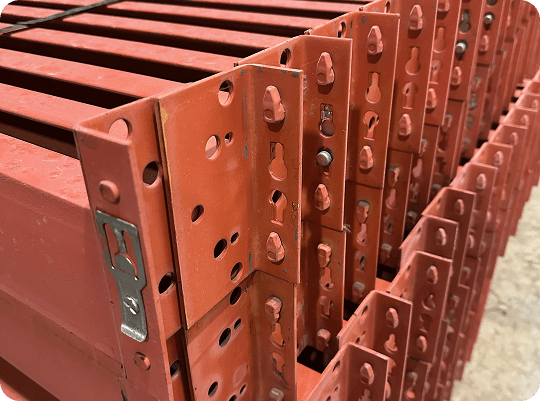
Whether you are planning pallet racking liquidation or liquidating your entire distribution center or warehouse, it is a major undertaking. You need careful planning to maximize your return. Here are the pallet-racking liquidation steps to take to make your process run smoothly.
The first step is a complete inventory of all assets tagged for liquidation. This includes:
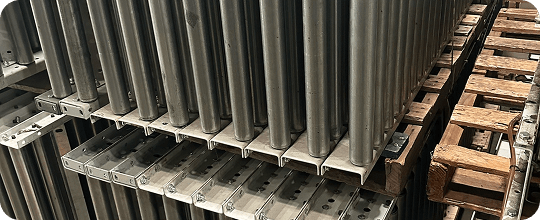
It helps you identify what should be resold vs. recycled or scrapped. It also aids with determining realistic pricing for assets when working with a liquidator. Photos and layouts can also help a liquidator establish fair market value, although generally, an on-site visit is required to assess equipment in person.
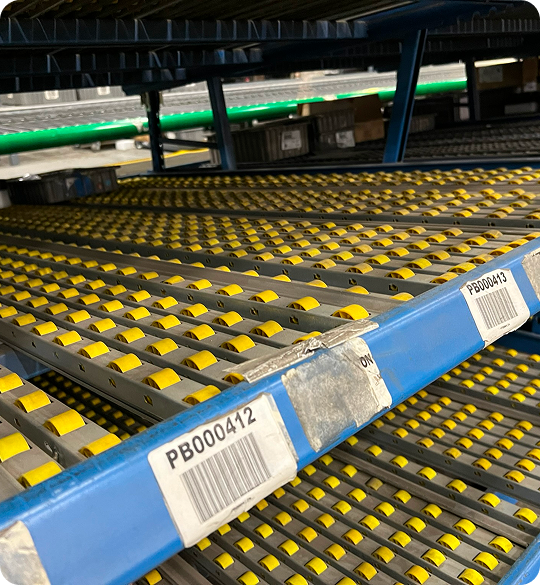
Whether you need a quick turn or have time to phase your liquidation, you will want to establish a timeline. You will need to factor in time for key milestones, such as:
Block out the expected duration of each phase, deliberately mapping out how the sequence of events will flow. An experienced pallet rack liquidation partner can help you create the roadmap and accelerate the timeline.
Avoid the temptation to schedule tasks back-to-back. Insert padding between each milestone to account for unexpected delays or complications. Rushing through a liquidation heightens the risks of accidents and missed steps. For example, you may plan for asset cleaning to take two days but discover it needs four days to fully prepare racks for transportation. With padding built in, you can accommodate such issues without throwing the entire timeline off track.
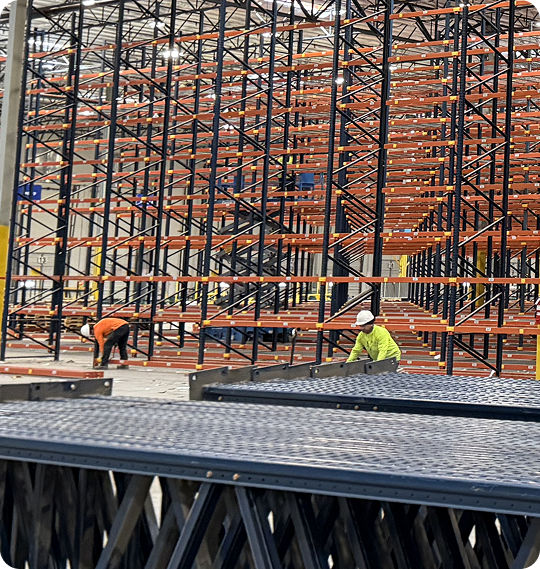
A critical component is determining a fair market value for your used warehouse equipment. You can look around online to get a general idea of pricing, but working with a material handling company that specializes in distribution center liquidation and used racking for sale is your best strategy to balance value vs. demand.
Pricing is determined by several key factors, such as:
Working with a distribution center liquidation that specializes in buying and selling used material handling equipment can establish a realistic value and make you an offer to ensure you get an accurate valuation.
To enable safe, efficient equipment dismantling and removal, you will need to prepare your facility. Here are some of the key things you will need to do.
Ensure uprights and beams can be safely lowered and transported out by clearing space around racking aisles. Remove any stored pallets, materials, or debris that might hinder movement.
As pallet racks and other equipment are dismantled, you need a staging area to store components temporarily. Designate a space within or directly outside the facility to store uprights, beams, and other assets after dismantling. This allows systematic bundling and loading of equipment for shipment. Consider logistics like ease of access for trucks and proximity to racking areas.
Note any portions of the facility that are off limits due to unsafe conditions for heavy equipment operation. For example, low clearance zones or narrow corner areas might prevent the safe use of equipment or cause other safety concerns. Physically block these spaces with barriers and signage to prevent accidental access.
Walk through the facility and identify any potential safety hazards or risks. Take proactive steps to mitigate dangers, like fixing cracks or holes in floors, securing unstable structures, covering sharp edges, and properly warning of fall risks or obstacles.
The work does not end once the last truck hauls away the final pallet rack components. Additional steps are typically required to restore the newly emptied facility. Depending on your plans for future use of the space, you may need to do several things.
With racks gone, sweep and mop the entire facility to remove any lingering debris, dust, and dirt. Clean offices, break rooms, and restrooms.
If you are liquidating and refurbishing your space to continue operations, consider if layout changes could optimize material flows, storage capacity, or workflow. For example, you may knock down select walls or build new partition walls to right-size and segment the space.
Inspect for any damage like cracks or holes in floors, damaged walls, unstable structures, etc. Make repairs to return the facility to its original structural integrity and appearance. For example, grinding any anchor bolts protruding from the floor to prevent safety hazards.
If necessary, make sure the facility is tidy and move-in ready for sale or handing off keys to new tenants per the terms of your lease. Oversee any final checks, walkthroughs, and paperwork to smoothly transfer control of the property.
Eliminate any previous company logos, signage, or branding throughout the facility. This includes exterior signs as well as any interior signage with the former company’s name or colors.

As you can see by the list of things you need to do to prepare for pallet racking liquidation and the sale of other assets, it is a big job. And we have not even talked about the sales process, marketing of equipment, and finding buyers.
These challenges are why most companies turn to professional and experienced distribution center liquidation specialists, like Conesco, which provides end-to-end liquidation services. Partnering with a qualified liquidation expert brings immense benefits that make outsourcing a smart choice.
A key advantage of outsourcing is having an experienced partner handle your entire liquidation from start to finish. They inventory your assets, value equipment, market to buyers, negotiate pricing, conduct systematic teardowns, haul away debris, and leave your facility broom-swept. This eliminates the need to coordinate and manage all the intricate details yourself.
Liquidation experts can complete the asset sale and facility restoration faster than your own employees. They have optimized processes and comprehensive resources to swiftly execute each phase. Your staff likely lacks the specialized experience to dismantle racks efficiently or effectively market used equipment.
Qualified partners have extensive buyer connections and insights into real-time market values for used assets. This helps maximize pricing and returns on sold equipment. Their relationships, selling power, and deal negotiation expertise provide an edge that individual sellers lack. This helps you maximize profits and accelerate timelines.
A key advantage of outsourcing is having an experienced partner handle your entire liquidation from start to finish. They inventory your assets, value equipment, market to buyers, negotiate pricing, conduct systematic teardowns, haul away debris, and leave your facility broom-swept. This eliminates the need to coordinate and manage all the intricate details yourself.
Liquidation experts can complete the asset sale and facility restoration faster than your own employees. They have optimized processes and comprehensive resources to swiftly execute each phase. Your staff likely lacks the specialized experience to dismantle racks efficiently or effectively market used equipment.
Choosing the right liquidation partner is crucial for a smooth process and maximizing returns. Like everything else in life, you get what you pay for. So, be wary of low bidders or new firms that may not have the specialized expertise required. You need to vet firms carefully to make sure you find the best fit for your liquidation.

Look for a company with specialized expertise in distribution centers and warehouse liquidations. They are better equipped to understand the marketplace and best practices, such as:
General auctioneers or liquidators often lack this critical expertise. They may fail to maximize your equipment’s value or commit costly errors. You want a partner intimately familiar with every aspect of the warehouse liquidation process.
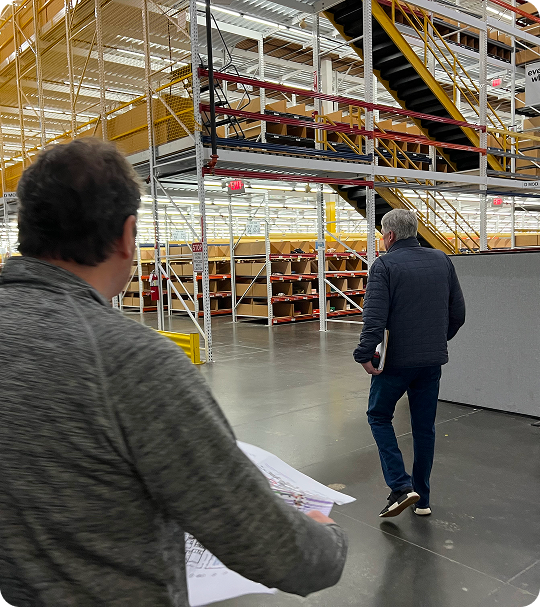
Along with specialization in distribution center liquidation, you also want to work with a company that has a proven track record of successful liquidations. One of the reasons people choose Conesco is because of a history of liquidations and a stellar track record for managing projects and maximizing returns.
Conesco is a nationwide company that handles large volumes of equipment purchasing and sales. This equates to specialized knowledge of the marketplace.
When choosing any partner, you should always ask for referrals from past clients with similar-sized facilities. Verify their prior projects were executed smoothly, achieved strong sale pricing, and left facilities in ideal conditions. An established record builds trust in a partner’s ability to deliver results. A lack of warehouse-specific experience is a red flag.
As part of the process of finding pallet rack liquidation near you, you will also want to evaluate the range of services that are offered. The fastest and most efficient way to liquidate is to work with a company that can provide end-to-end services.
A general liquidator may lack the experience in getting optimal value for used racking for sale or other warehouse equipment you are liquidating. Look for a company that has experience with the specific type of assets you are selling, such as:
In-depth industry knowledge helps accurately value equipment to make you get fair market value and handle the logistics safely and efficiently.
Well-connected partners have buyer relationships that you likely lack on your own. A company that buys and sells large volumes of used warehouse equipment will have established relationships. Partners will also have networks of asset removal professionals, scrap recyclers, and real estate contacts to streamline other aspects of your liquidation.
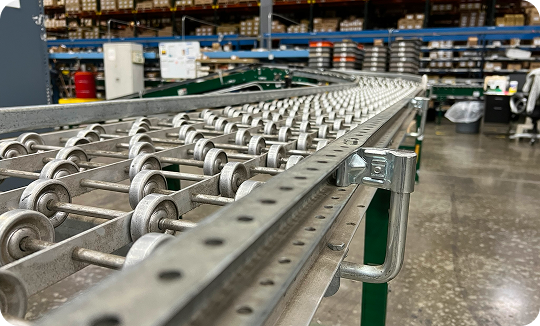
Choosing the right liquidation partner is the first step, but creating a productive working dynamic is equally important for project success. Here are some best practices you should employ.
Being fully transparent about your assets avoids surprises down the line. You need to accurately represent equipment conditions, capabilities, maintenance histories, and any other details that influence value. Surfacing issues late in the process can strain the relationship and disrupt your timeline.
Share comprehensive spec sheets covering every asset’s make, model, serial number, and dimensions, if available. This allows accurate remote assessments before on-site inspections.
Prevent miscommunications by aligning expectations for valuation approaches, timeframes, payment terms, service scope, safety protocols, etc. Put all details in writing so there is a clear understanding of responsibilities.
Keep communication open throughout the project. Immediately address any issues that emerge versus letting problems fester. Conduct progress check-ins at milestones and be responsive to requests for approvals or input needed to move things forward.
For more than 35 years, Conesco Storage Systems has perfected the distribution center liquidation process. Conesco’s team of material handling experts will rapidly catalog, value, and connect sellers to qualified buyers. The team also manages safe teardown, debris removal, and facility restoration from start to finish, maximizing your returns on sold assets.
With multiple locations nationwide, Conesco can expertly handle projects of any size and scope.
Contact Conesco Storage Systems today to discuss your pallet racking liquidation or distribution center liquidation plans.
Here are some of our most frequently asked questions about selling used pallet racking and other warehouse equipment:
How long a distribution center liquidation will take depends on the amount of equipment you have and the work that has to be done. For example, if you are continuing to operate while liquidation is going on, it will likely take phasing, which can add to time. Whether uprights are bolted to the ground, or freestanding also impacts timelines.
Conesco will work with you to create a reasonable timeline that meets your deadlines. If possible, you want to give yourself a couple of months. If you do not have that kind of time, we can work with you to get the job done.
Conesco provides expert solutions for all your material handling needs. Our team is ready to assist you in finding the right equipment for your project. Fill out the form to get started!